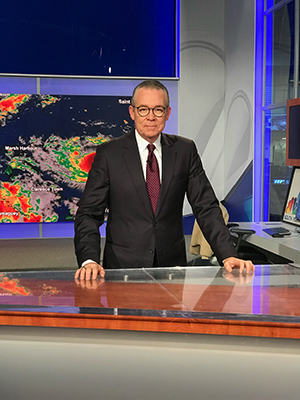Castles in the Sand
Part 1 of a story in four parts about what climate change means for real estate and what we can do about it.

“Climate change is sometimes misunderstood as being about changes in the weather. In reality it is about changes in our very way of life.” —Paul Polman
The urge to build is a human compulsion. Sure, we love to create—but we need a place where we can feel safe. For most of us, the notion of home is synonymous with security and comfort. And while the world outside might change, indoors we’re protected from all that. Or so we assume.
Climate change undermines many of our assumptions about the safety and security of the buildings in which we live and work. Increasingly, our built environment is being exposed to sudden shocks, from storms and fires to flash floods, as well as more gradual phenomena, such as more extreme heat, sea level rise, subsidence, and erosion.
In addition to the human impacts, the economic cost of climate change on real estate will be considerable. At present, housing alone accounts for some 15-18% of U.S. GDP; in 2020, according to Savill’s, the value of all the world’s real estate reached $326.5 trillion in 2020. But McKinsey has calculated that climate risks could reduce returns on real estate investment by a whopping 40% this decade. Globally, insurance premiums are set to soar 22% by 2040.
And then there are the broader social contexts being impacted by climate change. Climate shocks can cause resource, food, and water shortages, causing social turmoil and huge economic fluctuations. Longer-term changes are triggering new patterns of human migration.
The bottom line is, wherever we live, climate change will find us. That means the way we build—the how, why and where of our built environment—must also change.
Writing in the Washington Post, award-winning meteorologist and Cornell alumnus John Toohey ’84, aka John Morales, concisely sums up the situation: “We cannot afford this business as usual.”
The city by the sea
Arguably, Miami, Florida illustrates the threat posed by our new climate reality more forcefully than anywhere else in America. As reported by Scientific American, sea level rise makes Miami the most at-risk city not just in America, but in the world.

“When you think about the multiple challenges the climate crisis brings, I think sea level rise is the existential threat here and one which is a lot more evident today than it was just 25 years ago,” says Toohey, who studied atmospheric sciences at Cornell’s College of Agriculture and Life Sciences before going on to spend over three decades in Miami presenting the weather on TV. While becoming a household name in Florida as meteorologist John Morales, he’s been ideally positioned to observe the changes that have taken place.
“What you have to understand is that the city now has the largest amount of assets at risk from sea level rise anywhere,” Morales says.
Miami’s sea level is expected to rise as much as 5 to 6 feet by the end of the century, according to an article in Yale Environment 360. With the city’s present average elevation above sea level at just under 6 feet, many neighborhoods lie well below that. That poses a direct threat to the city’s people, and to Florida’s $1 trillion economy. The Risky Business project has found that between $15 billion and $23 billion of the city’s property could be underwater by 2050. Even in the absence of hurricanes and major storms, southern Florida is seeing an increase in “sunny day floods,” where high tide simply fills streets and homes with seawater. By 2050, these are forecast to occur between 10 and 50 days each year. Not for nothing did the Miami Herald describe an incident in which an octopus was discovered in a parking garage as “climate change’s canary in the coalmine.”
More alarming still, last year’s tragic collapse of a condo tower in Surfside, Miami Dade County, which killed 98 people, put many observers on high alert. Despite denials among Florida officialdom that the disaster had anything to do with sea level rise, researchers and engineers say a wealth of anecdotal evidence supports the possibility that saltwater corrosion of the foundations could have contributed to the collapse.
Growth surges and rising climate risks

And yet, remarkably, Miami is going through a historic housing boom. In July, the city topped the list of least affordable U.S. housing markets, ahead of Los Angeles and New York. In fact, research by Justin Murfin, associate professor at the Charles H. Dyson School of Applied Economics and Management, and collaborator Matthew Spiegel from Yale University, “found no evidence of a clear link between coastal real estate prices and the threat of inundation due to sea level rise,” Murfin says. Breathless sales websites gush over the ultra-luxury condos being planned right now, in flood-prone neighborhoods, with no mention of sea level rise. Developers keep building luxury tower blocks and condominiums, and investors keep buying them.
One reason for this, Toohey suggests, stems from the overhaul of the U.S. tax code in 2017. “This led to an influx of wealthy people from states like New York and California, where the taxes are very high. [Those] folks have come to Florida, where there is no state income tax,” he says. As local government revenues in Florida depend heavily on real estate sales and property taxes, officials have a strong incentive to greenlight as many lavish developments as possible.
Another reason might lie in what might be described as a lack of joined-up thinking. While Miami and its surrounding municipalities have declared climate emergencies at the city commission level and are taking steps to cut carbon emissions, little is happening at the state level on this front. Instead, state-level climate efforts are focused on climate adaptation—that is, reacting to and preparing for instances of flooding and heatwaves, with perhaps less interest in the broader, long-term picture.
“So that means a lot of spending on raising roads, a lot of spending on potential buyouts of properties that are in flood zones, and a lot of money on water management,” says Toohey, who is also an advisory committee member at the Cornell Atkinson Center for Sustainability.
Miami mayor Francis X. Suarez has said, “We don’t have the luxury of denying what we see happening,” claiming his city is “ground zero for climate change, but we’re also the model for adaptation.” The mayor is a proponent of pump stations that suck up the water pouring into the city and push it back out and turning the city’s parks into “natural” reservoirs. There are also plans afoot to build a $6 billion dollar sea wall across the bay.
Limitations of adaptation
Suarez says Miami is creating a “scalable national model that you can take to the rest of the world,” but many experts doubt whether such incremental efforts will succeed. Some urge prioritizing nature-based solutions instead, such as mangrove plantations that help protect the coast against hurricanes, while others are calling to require underground parking garages to serve as temporary reservoirs when floods take place. And in areas like Miami Beach, an island city adjoining Miami that averages four feet above sea level, researchers believe no amount of adaptation will prevent chronic severe flooding from taking place. As Toohey is fond of saying, “resilience has its limits in Florida—big time.”
Meanwhile, efforts at adaptation across Miami have also been unequal, with researchers noting that many projects have focused on wealthy neighborhoods. Internal friction is mounting as wealthy developers and owners attempt to buy up land on Miami’s highest ground, the Atlantic Coastal Ridge, where Black and Afro-Caribbean families established communities in the 20th century. Now, with low-lying areas looking less appealing, that higher ground is the setting for “climate gentrification”—a trend taking place in many cities throughout the world as the wealthy and the powerful flee climate impacts.
As one realtor told Florida’s WUSF radio: “Before it was location, location, location. Now, it’s about elevation, elevation, elevation. The new buyer has to worry about both.”
Miami is just one city among thousands. But as an American example of what happens when human-caused climate change meets our built environment, it is unparalleled. On a national, even global scale, Miami itself is a canary in the coalmine. From sea level rise and hurricanes on the east coast to wildfires and water shortages in the west, change is coming.
The question for all cities must be: What is to be done?
Action stations: The need for public/private collaboration
In order for society to respond adequately and equitably to the climate challenge, experts who study the problem say all stakeholders, from policymakers to planners, from homeowners to real estate developers, need to be on board. But where does that process begin?

First of all, anyone concerned with what our climate future holds needs to engage with what the science says, notes Linda Shi, assistant professor in the Department of City and Regional Planning at Cornell’s College of Architecture, Art and Planning (AAP).
“You need a recognition that climate change is real or at least that weather changes are happening,” says Shi, who is also a Cornell Atkinson faculty fellow. “At some point, there needs to be science about what those changes mean for that particular place, to give at least some general sense of the types of impacts that you’re going to see.”
Next, Shi says, cities can help protect what already exists by introducing new codes and standards for new developments, routine maintenance, and capital investments. After all, she points out, cities aren’t static, unchanging entities: “The built environment is constantly being reproduced and is constantly changing, so you can factor that in.”
And it may sound like a no-brainer, but cities should also not choose to put more buildings on land that is prone to flooding.
“Sooner or later, you’re going to get a flood that exceeds whatever baseline you’ve built to,” Shi says. “It’s an absolute probability: you will, at some point, exceed it.” Real estate investors and developers are accustomed to building to a “financially palatable” level of risk—but in our new climate reality, historic frequencies are quickly changing. A “one-in-100-year” climate event may begin occurring every five years, for example. Generations-old assumptions no longer hold true.

To effect and carry out large-scale change, all major players have to be on the same page, says Daniel Lebret, senior lecturer in real estate finance at the Cornell Peter and Stephanie Nolan School of Hotel Administration and former director of graduate studies for the Cornell Baker Program in Real Estate. For one thing, legislators need to design public policy, such as tax incentives, that rewards climate-compatible behavior by private enterprise. In addition, zoning and redistricting rules must be crafted with an eye not just towards resilience, but to equitable outcomes for the less well-off.
“Collaborations between the public and the private sector add up to more than the sum of its individual components when done correctly,” Lebret says—a view supported both by bodies such as the World Bank and by NGOs that specialize in climate solutions. While the public sector can regulate and adjust fiscal policy to direct capital to certain areas, they also require the innovation and financial might of the private sector to make those initiatives happen. On the other hand, the private sector needs the guarantee that its capital will be safe and that the legal landscape is not going to shift dramatically.
The need for such collaboration is a key reason why Cornell’s Baker Program addresses features of both the private sector and the public sector: The idea is to prepare real estate practitioners to enter work with a more holistic view of development and the built environment. That’s also why Lebret and Brad Wellstead, a lecturer at the Nolan Hotel School, led a group of some 60 Baker Program students to Miami in April. The party met business leaders, researchers, and local officials for conversations about sustainable urban development and climate resilience.
The Paul Rubacha Department of Real Estate
Taking this ethos a step further, Cornell unveiled a new proposition for bringing business and the public sector together. In June 2022, the university established the Paul Rubacha Department of Real Estate, a multidisciplinary, multi-college platform that “will expand and enhance a program that integrates finance, development and the built environment in an unprecedented way,” according to an announcement in the Cornell Chronicle. Together, the Cornell College of Architecture, Art, and Planning and the Cornell SC Johnson College of Business will manage the new department, providing the faculty and staff expertise in real estate education, research and outreach, and creating “a thoughtful real-estate education unlike any other program in the country—one that’s as focused on design and development as it is on the balance sheet,” as Provost Michael I. Kotlikoff noted.
Such an ambitious endeavor carries risks: loading an academic program up with multiple fields of inquiry might threaten to make the curriculum weightier than that of competing courses from rival schools.

But the upside is potentially huge. As Andrew Karolyi, Charles Field Knight Dean of the SC Johnson College, put it when interviewed by Fortune magazine about the Paul Rubacha Department: “We think that the students out there in the marketplace are very much craving a holistic perspective on real estate as far as their training goes for their long-term careers. They could become property developers, or work on the asset management side of a ledger, or the operational side of it, or on the design side of it. Knowing all aspects of it is our big differentiator with this program.”
The new department, then, will aim to fulfill high expectations. Given the scale and immediacy of the challenge facing everyone everywhere, relying on business as usual is a recipe for failure—something the world can ill afford.
Climate change and its impact on real estate: A story in four parts
Learn more about the impact of climate change on real estate in other, upcoming stories in this series:
- Castles in the Sand: What climate change means for real estate, and what we can do about it.
- Dynamic Properties: From investment opportunities to risk protection and energy savings, climate change awareness is sparking transformation in real estate.
- Redressing the balance: Equitable approaches to sustainable real estate
- Everything Everywhere All at Once: Why, when it comes to real estate, tackling climate change means changing how we learn.
